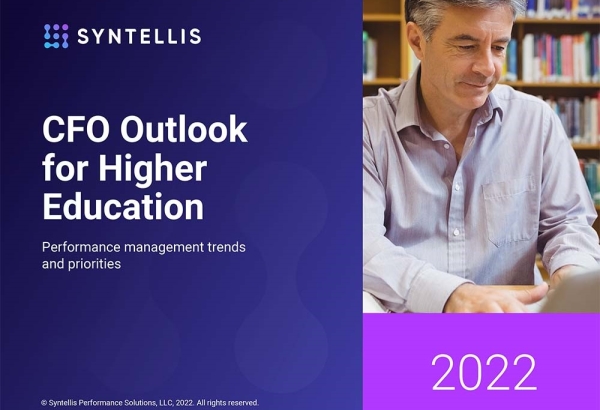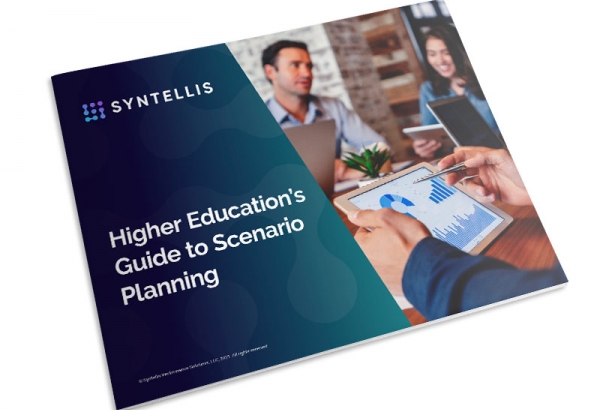In just a few years, colleges and universities expect sharp enrollment declines as they tumble over the “demographic cliff.”
What is the college enrollment cliff? Why is college enrollment declining? According to college enrollment projections, the declines will result from a decrease in traditional college-age students due to a significant drop in children born in the aftermath of the 2008 financial crisis. The birth rate dropped 9% between 2007 and 2013, according to the Centers for Disease Control and Prevention.1 Those babies will soon be of college age.
Most institutions depend on tuition as a large portion of their budgets. Without those revenues, there can be no mission. According to a recent Syntellis Performance Solutions report, more than half of higher education finance professionals view the demographic cliff as a top concern that will have sizable financial impacts on their institutions over the next five to 10 years.2
Colleges and universities nationwide already report decreased enrollment and faltering retention rates due to the reverberations of the COVID-19 pandemic. Savvy higher education leaders should act now to stem losses as they approach the impending enrollment cliff — expected to hit beginning in 2025 — and traditional methods may not be enough.
In years past, finance leaders often developed strategic financial plans with the assumption of growing enrollment. Today, leaders need to fully understand the financial implications of the college and university enrollment decline, evaluate their strategic plans, and build flexibility to plan for a variety of scenarios given the unstable admissions environment.
A panel of campus financial leaders recommended the following five strategies to counter enrollment challenges in a recent Chronicle of Higher Education webinar sponsored by Syntellis Performance Solutions.
1. Rethink college readiness
Many college and university leaders see college readiness in a different light thanks to COVID-19. They now ask themselves whether students are ready to tackle the rigors of a college-level curriculum given the unusual educational experience over the past few years. If not, institutional leaders should consider revising their admissions standards and offer additional support to help those students succeed.
For example, the pandemic has fueled a long-standing debate in higher education on how accurately standardized test scores predict college readiness. As a result, more institutions waived admissions testing requirements or changed how test scores factor into their overall enrollment decisions.
2. Expand your recruiting reach.
Many small or mid-sized colleges and universities draw a majority of their enrollment from within a 150-mile radius. They typically are not well known in communities outside those areas. Building brand awareness and expanding beyond those boundaries may help offset some of the losses experienced within traditional recruitment areas.
Institutions looking to establish a regional or national footprint may consider establishing a regional network of representatives in different cities and states. They also should evaluate and adjust recruitment practices. Especially during the height of the pandemic, college recruiters could not use many of their traditional methods, such as in-person college fairs. Much of the focus has shifted online and recruiters need to adapt.
3. Grow market share.
Higher education leaders should evaluate their current market share and identify areas where market share increased and decreased. Decreases can indicate opportunities to recapture brand awareness, while increases might reveal successful strategies that could work elsewhere.
In addition to geographic areas, leaders should consider trends occurring in the types of students they typically enroll. If they historically enroll high levels of Pell-eligible students for example, they may see a drop-off in those numbers due to the economic turbulence of recent years. If so, they may need to extend additional aid and support for those populations, as well as expand their focus to other student populations.
Many institutions also are growing alternative programs — such as certificate or short-term degree programs — to expand their offerings and grow enrollment of non-traditional students leading up to the enrollment cliff in higher education.
4. Prioritize retention.
Many colleges and universities have an intense focus on attracting new student enrollment, while retaining existing students tends to be a lower priority. To successfully navigate current and future enrollment challenges, higher education leaders should ensure their institutions support students from admission through graduation. Increasing retention and completion rates is one more way to aid the bottom line, and it can be a more efficient use of resources compared to new student recruitment strategies.
Consider developing warning systems to identify struggling students in need of additional assistance. Those signals may be academic, economic, social, or some other factor. The key is to make sure all students have resources to help them succeed and feel engaged with the school.
5. Promote diversity.
Increasing diversity on college campuses is a huge priority for institutions nationwide. Higher education leaders should evaluate the resources committed to diversity initiatives, including recruiting pipelines and support systems offered to students coming from a variety of backgrounds and experiences. In some cases, institutions may need to invest in additional financial aid and expand programmatic offerings to serve a broader population.
Bringing in expertise in the form of a chief inclusion officer or chief diversity officer can help college administrators identify barriers and opportunities for improvement to develop effective diversity plans.
Preparing for an uncertain future
Each of these strategies has financial implications and trade-offs. For example, adding new services for remedial students, new programs that appeal to minority students, or additional student aid for low-income students all come at a cost. Leaders need the ability to project those costs and to analyze the true costs of existing programs so they can begin to right-size and reinvent their institutions as they near higher education’s demographic cliff. Only with that information can they have difficult, but necessary, conversations about which programs to cut and which to prioritize going forward.
College and university officials also need flexibility. COVID-19 caused many institutions to scrap pre-pandemic five-year strategic and financial plans, especially as it relates to enrollment. Leaders need the ability to quickly adjust plans in response to market changes and broader higher education trends. There is no crystal ball that can predict what will happen over the next five to 10 years, so institutional leaders need to consider multiple scenarios and strategies.
Solutions such as Syntellis’ AxiomTM Higher Education Suite include scenario modeling capabilities that empower finance officials to run different enrollment scenarios, quantify the potential impacts of declining enrollment in colleges, and develop actionable strategies to address various challenges that may arise. Such tools allow colleges and universities to prepare and quickly adapt to change in these uncertain times.
1Centers for Disease Control and Prevention: “NCHS Births and General Fertility Rates: United States.” Accessed March 9, 2022.
Learn more about Axiom in higher education

CFO Outlook for Higher Education: Planning for Uncertainty

The Demographic Cliff: Surviving Enrollment Challenges


